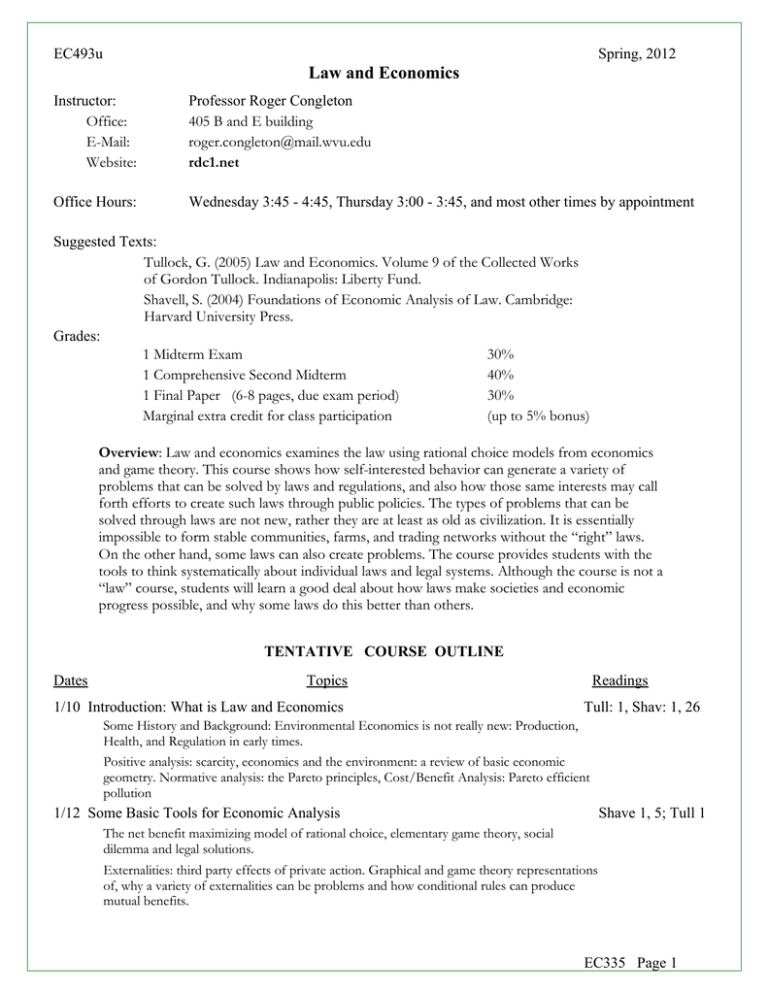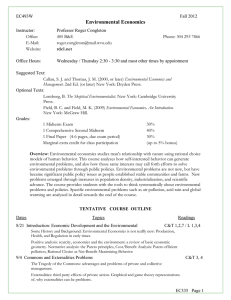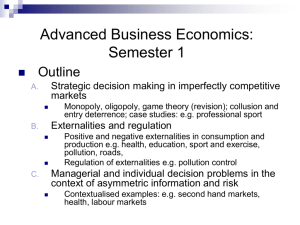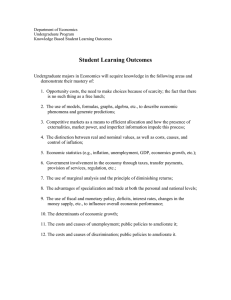Law and Economics
advertisement

EC493u Spring, 2012 Law and Economics Instructor: Office: E-Mail: Website: Professor Roger Congleton 405 B and E building roger.congleton@mail.wvu.edu rdc1.net Office Hours: Wednesday 3:45 - 4:45, Thursday 3:00 - 3:45, and most other times by appointment Suggested Texts: Tullock, G. (2005) Law and Economics. Volume 9 of the Collected Works of Gordon Tullock. Indianapolis: Liberty Fund. Shavell, S. (2004) Foundations of Economic Analysis of Law. Cambridge: Harvard University Press. Grades: 1 Midterm Exam 30% 1 Comprehensive Second Midterm 40% 1 Final Paper (6-8 pages, due exam period) 30% Marginal extra credit for class participation (up to 5% bonus) Overview: Law and economics examines the law using rational choice models from economics and game theory. This course shows how self-interested behavior can generate a variety of problems that can be solved by laws and regulations, and also how those same interests may call forth efforts to create such laws through public policies. The types of problems that can be solved through laws are not new, rather they are at least as old as civilization. It is essentially impossible to form stable communities, farms, and trading networks without the “right” laws. On the other hand, some laws can also create problems. The course provides students with the tools to think systematically about individual laws and legal systems. Although the course is not a “law” course, students will learn a good deal about how laws make societies and economic progress possible, and why some laws do this better than others. TENTATIVE COURSE OUTLINE Dates Topics 1/10 Introduction: What is Law and Economics Readings Tull: 1, Shav: 1, 26 Some History and Background: Environmental Economics is not really new: Production, Health, and Regulation in early times. Positive analysis: scarcity, economics and the environment: a review of basic economic geometry. Normative analysis: the Pareto principles, Cost/Benefit Analysis: Pareto efficient pollution 1/12 Some Basic Tools for Economic Analysis Shave 1, 5; Tull 1 The net benefit maximizing model of rational choice, elementary game theory, social dilemma and legal solutions. Externalities: third party effects of private action. Graphical and game theory representations of, why a variety of externalities can be problems and how conditional rules can produce mutual benefits. EC335 Page 1 1/26 III. Property as Solutions to Conflict and Commons Problems Shav: 1, 2, 5, 13; Tull: 1, 2 An economic explanation for the origins and limits of property rights over produced goods and land. Ownership as a bundle of rights and limits 2/2 IV. Property, Trade, Contract, and the Courts Shav 8, 10; Tull 6 Economic effects of tradable outputs. Contracts as solutions to team production problems. The courts as information producing and enforcement institutions. The logic of crime and crime prevention. 2/16 IV. Torts: On Rules for Dealing with Accidents and Externalities Shav 8, 10; Tull 6 Accidental externaliteis and reasonable care. Alternative rules for dealing with accidents and other externalities. Strict Liability, Negligence, and Contributory Negligence 2/28 3/1 3/6 Review for Exam Exam Review of Exam Study Guide I 3/6 V. Politics of Public Law: Regulation, Public Interests, Voters, and Interest Groups. Distributional and efficiency effects of public law. Voter and interest group interests in stronger regulations than provided by civil law. Their different interests in regulation of externalities and monopolies. 4/3 4/10 4/17 4/19 424 Applications: Patents and Anti-Trust Law Applications: Constitutional Law Review for Second Exam Second Exam Review of Second Exam Study Guide II 4/26 Applications and class overview Economic development and the economic constitution: framing the free market 5/2 Final 6-8 Page Paper Due at roger.congleton@mail.wvu.edu (11:59 p.m.--Via E-mail) EC335 Page 2



